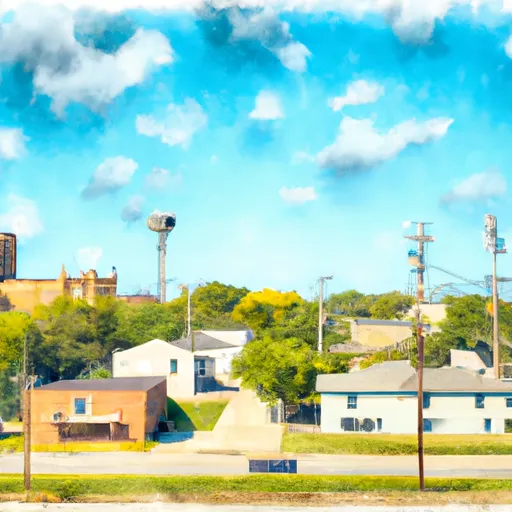-
 Snoflo Premium
Snoflo Premium
Get unlimited access to all our content
With no Ad interruptions! - Start Your Free Trial Login with existing account
Saint-Marys
Eden Index
Climate
8.3
•
Recreation
0.3
•
Community
1.9
•
Safeguard
3.9/10

Saint Marys is a small town located in northeast Kansas, known for its pleasant climate, diverse hydrology constituents, and various outdoor recreation opportunities. The town experiences a humid continental climate, with warm summers and cold winters. Average temperatures in summer range from 70-90°F (21-32°C), while in winter, temperatures can drop to as low as 20°F (-7°C).
The hydrology constituents of Saint Marys include the nearby Kansas River and several small creeks. The Kansas River provides opportunities for water-based activities like fishing, boating, and kayaking. The creeks offer serene settings for hiking, birdwatching, and picnicking.
Outdoor recreation enthusiasts can enjoy the picturesque Flint Hills region near Saint Marys. The area provides vast opportunities for hiking, biking, and horseback riding, with its rolling hills and scenic landscapes. The Flint Hills Nature Trail, a popular recreational trail, stretches over 117 miles and offers unique experiences for nature lovers.
In addition, Saint Marys hosts several community events and festivals throughout the year, including the popular Potawatomi Powwow, showcasing Native American culture. Overall, Saint Marys provides a welcoming atmosphere for outdoor enthusiasts to explore its natural beauty and enjoy a variety of recreational activities.
What is the Eden Index?
The Snoflo Eden Index serves as a comprehensive rating system for regions, evaluating their desirability through a holistic assessment of climate health, outdoor recreation opportunities, and natural disaster risk, acknowledging the profound impact of these factors on livability and well-being.
Climate Health Indicator (CHI): 8.3
Saint-Marys receives approximately
888mm of rain per year,
with humidity levels near 82%
and air temperatures averaging around
13°C.
Saint-Marys has a plant hardyness factor of
6, meaning
plants and agriculture in this region thrive during a short period during spring and early summer. Most
plants will die off during the colder winter months.
By considering the ideal temperature range, reliable water supplies, clean air, and stable seasonal rain or snowpacks, the Climate Health Indicator (CHI) underscores the significance of a healthy climate as the foundation for quality living.
A healthy climate is paramount for ensuring a high quality of life and livability in a region, fostering both physical well-being and environmental harmony. This can be characterized by ideal temperatures, reliable access to water supplies, clean air, and consistent seasonal rain or snowpacks.
Weather Forecast
Streamflow Conditions
Kansas
Area Rivers
Kansas
Snowpack Depths
Kansas
Reservoir Storage Capacity
Kansas
Groundwater Levels
Recreational Opportunity Index (ROI): 0.3
The Recreational Opportunity Index (ROI) recognizes the value of outdoor recreational options, such as parks, hiking trails, camping sites, and fishing spots, while acknowledging that climate plays a pivotal role in ensuring the comfort and consistency of these experiences.
Access to outdoor recreational opportunities, encompassing activities such as parks, hiking, camping, and fishing, is crucial for overall well-being, and the climate plays a pivotal role in enabling and enhancing these experiences, ensuring that individuals can engage in nature-based activities comfortably and consistently.
Camping Areas
| Campground | Campsites | Reservations | Toilets | Showers | Elevation |
|---|---|---|---|---|---|
| Sun Dance - Melvern Lake | None | 1,079 ft | |||
| Toronto Point - Cross Timbers State Park | 200 | 936 ft | |||
| White Hall Bay - Fall River Lake | 30 | 979 ft | |||
| Manns Cove - Cross Timbers State Park | 20 | 943 ft | |||
| Fall River State Park | 165 | 995 ft | |||
| Centralia Lake | None | 1,285 ft | |||
| Damsite - Fall River Lake | 30 | 926 ft | |||
| Holliday Hill - Cross Timbers State Park | 30 | 918 ft | |||
| St Marys Riverside Park | None | 944 ft | |||
| Rock Ridge Cove North - Fall River Lake | 45 | 973 ft |
Nearby Fishing
Catastrophe Safeguard Index (CSI):
The Catastrophe Safeguard Index (CSI) recognizes that natural disaster risk, encompassing floods, fires, hurricanes, and tornadoes, can drastically affect safety and the overall appeal of an area.
The level of natural disaster risk in a region significantly affects safety and the overall livability, with climate change amplifying these risks by potentially increasing the frequency and intensity of events like floods, fires, hurricanes, and tornadoes, thereby posing substantial challenges to community resilience and well-being.
Community Resilience Indicator (CRI): 1.9
The Community Resilience Indicator (CRI) recognizes that education, healthcare, and socioeconomics are crucial to the well-being of a region. The CRI acknowledges the profound impact of these elements on residents' overall quality of life. By evaluating educational resources, healthcare accessibility, and economic inclusivity, the index captures the essential aspects that contribute to a thriving community, fostering resident satisfaction, equity, and social cohesion.

